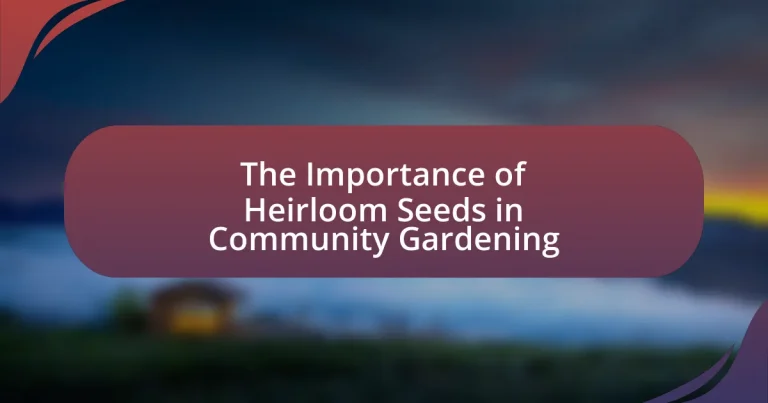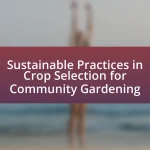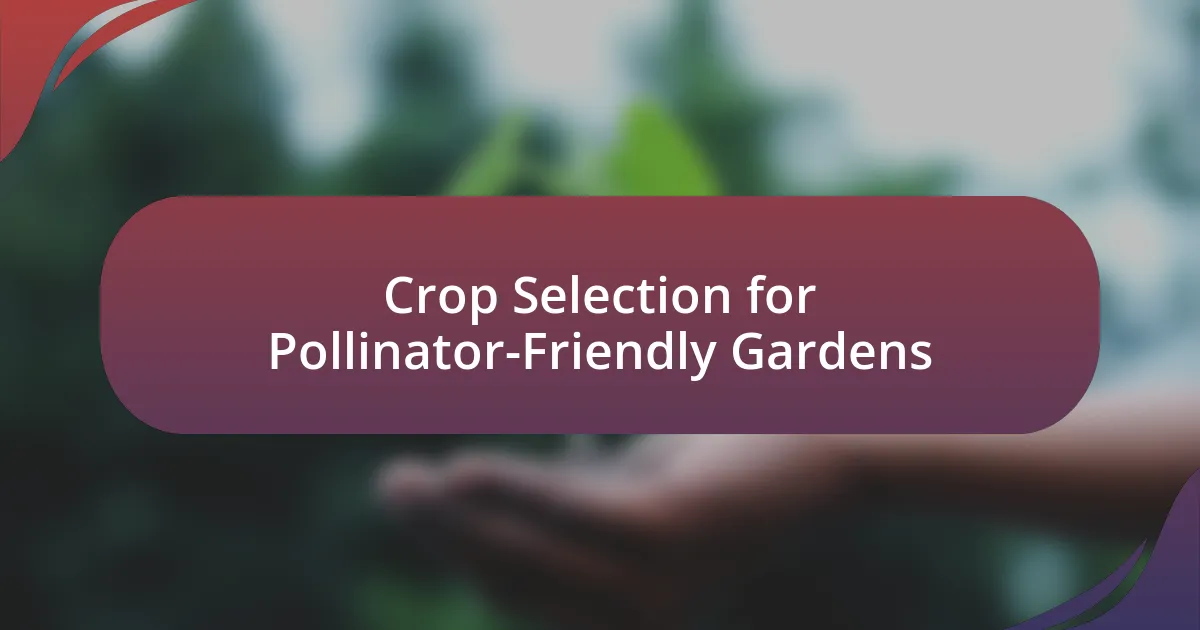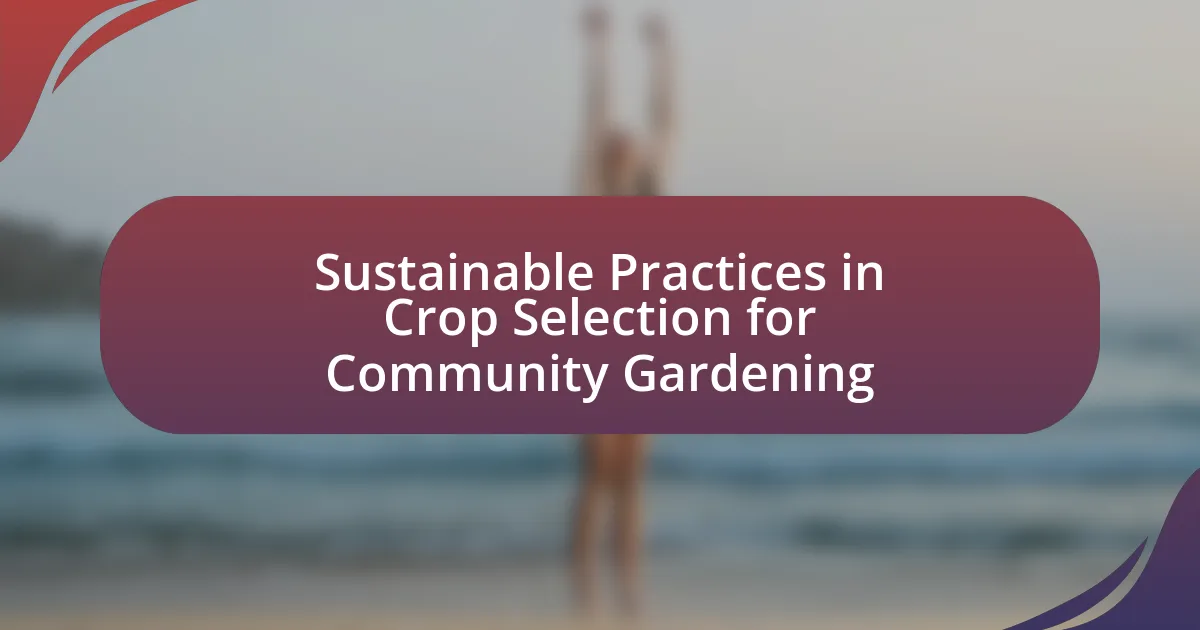Heirloom seeds are open-pollinated seeds that have been preserved for generations, valued for their genetic diversity and unique traits. This article explores the significance of heirloom seeds in community gardening, highlighting their role in promoting biodiversity, enhancing flavor and nutrition, and fostering community engagement. It discusses the differences between heirloom, hybrid, and GMO seeds, the characteristics that define heirloom varieties, and their contributions to sustainable agriculture and local ecosystems. Additionally, the article addresses the challenges associated with using heirloom seeds, misconceptions about their cultivation, and practical tips for successful gardening practices.
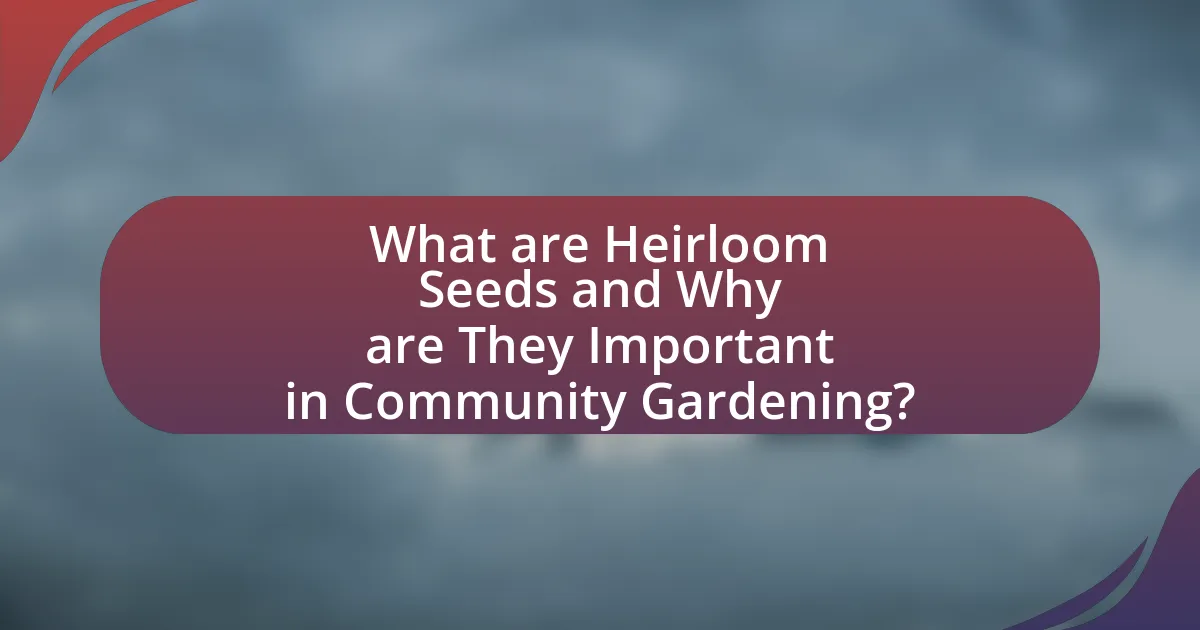
What are Heirloom Seeds and Why are They Important in Community Gardening?
Heirloom seeds are open-pollinated seeds that have been passed down through generations, often for 50 years or more, and are valued for their genetic diversity and unique traits. These seeds are important in community gardening because they promote biodiversity, allowing gardeners to cultivate a wide variety of plants that are well-adapted to local conditions, which can enhance resilience against pests and diseases. Additionally, heirloom seeds often have superior flavor and nutritional value compared to hybrid varieties, contributing to healthier food options within the community. Their preservation supports sustainable gardening practices and fosters a sense of community by encouraging the sharing of seeds and gardening knowledge among members.
How do heirloom seeds differ from hybrid and GMO seeds?
Heirloom seeds differ from hybrid and GMO seeds primarily in their genetic stability and breeding methods. Heirloom seeds are open-pollinated varieties that have been passed down through generations, maintaining their traits over time, while hybrid seeds are created through controlled cross-pollination to produce specific characteristics, and GMO seeds are genetically modified using biotechnology to introduce new traits. Heirloom seeds typically offer greater biodiversity and flavor, as they are often selected for taste and adaptability to local conditions, whereas hybrids and GMOs may prioritize yield and pest resistance. Historical data shows that heirloom varieties can contribute to sustainable agriculture by preserving genetic diversity, which is crucial for food security.
What characteristics define heirloom seeds?
Heirloom seeds are defined by their ability to be open-pollinated, meaning they can reproduce true to type in subsequent generations. These seeds are typically at least 50 years old and have been passed down through generations, often selected for their unique flavors, colors, and adaptability to local growing conditions. Heirloom varieties maintain genetic diversity, which is crucial for resilience against pests and diseases, and they often contribute to sustainable agricultural practices by promoting biodiversity.
Why are heirloom seeds considered more sustainable?
Heirloom seeds are considered more sustainable because they are open-pollinated, allowing them to be saved and replanted year after year without losing their genetic integrity. This practice promotes biodiversity and reduces dependency on commercial seed sources, which often involve hybrid varieties that cannot be saved. Additionally, heirloom seeds are typically well-adapted to local growing conditions, requiring fewer resources such as water and fertilizers, which further enhances their sustainability. Studies have shown that maintaining genetic diversity through heirloom seeds can lead to more resilient ecosystems, supporting both environmental health and food security.
What role do heirloom seeds play in preserving biodiversity?
Heirloom seeds play a crucial role in preserving biodiversity by maintaining genetic diversity within plant species. These seeds are open-pollinated varieties that have been passed down through generations, often adapted to local climates and conditions. By cultivating heirloom seeds, gardeners contribute to the conservation of unique traits and characteristics that may be lost in commercial hybrid varieties, which often prioritize uniformity and yield over diversity. Studies indicate that heirloom varieties can possess greater resilience to pests and diseases, thereby supporting ecosystem stability. Furthermore, the preservation of heirloom seeds helps safeguard against the loss of plant species, as they represent a living genetic reservoir that can be vital for future breeding and adaptation efforts.
How do heirloom seeds contribute to genetic diversity in crops?
Heirloom seeds contribute to genetic diversity in crops by preserving a wide range of genetic traits that have been cultivated over generations. These seeds are open-pollinated, meaning they can reproduce true to type, allowing for the continuation of diverse characteristics such as disease resistance, adaptability to local climates, and unique flavors. Research indicates that heirloom varieties can contain genetic traits that modern hybrids lack, which is crucial for breeding programs aimed at enhancing resilience in the face of climate change and pests. For example, a study published in the journal “Agricultural Systems” highlights that heirloom crops can provide essential genetic material for developing new varieties that are better suited to changing environmental conditions.
What impact do heirloom seeds have on local ecosystems?
Heirloom seeds positively impact local ecosystems by promoting biodiversity and enhancing soil health. These seeds, which are open-pollinated and have been passed down through generations, contribute to a diverse gene pool that supports various plant species, attracting beneficial insects and wildlife. Research indicates that diverse plant communities can improve ecosystem resilience, as seen in studies showing that increased plant variety leads to better pest control and pollination services. Additionally, heirloom varieties often require fewer chemical inputs, which reduces environmental pollution and fosters healthier soil microbiomes. This ecological balance is crucial for sustainable community gardening practices.
Why are heirloom seeds significant for community identity?
Heirloom seeds are significant for community identity because they embody local agricultural heritage and cultural traditions. These seeds have been passed down through generations, often adapted to specific regional climates and soils, which fosters a sense of belonging and continuity among community members. For example, communities that cultivate heirloom varieties often celebrate their unique histories and agricultural practices through festivals and shared gardening experiences, reinforcing social bonds and collective identity. Additionally, the preservation of heirloom seeds contributes to biodiversity, which is crucial for sustainable agriculture and food security, further solidifying their importance within the community context.
How do heirloom seeds connect communities to their agricultural heritage?
Heirloom seeds connect communities to their agricultural heritage by preserving genetic diversity and traditional farming practices. These seeds are often passed down through generations, embodying the history and culture of local farming communities. For example, heirloom varieties like Cherokee Purple tomatoes or Blue Lake green beans have specific stories and adaptations that reflect the agricultural practices of the regions they originate from. By cultivating these seeds, communities maintain a link to their past, fostering a sense of identity and continuity in their agricultural practices. This connection is further reinforced through community gardening initiatives, where shared cultivation of heirloom seeds promotes collaboration, knowledge exchange, and a collective appreciation for local agricultural history.
What stories and traditions are associated with heirloom seeds?
Heirloom seeds are associated with rich stories and traditions that reflect cultural heritage and agricultural practices. These seeds often carry historical significance, having been passed down through generations, representing the unique agricultural practices of specific communities. For example, many heirloom varieties were cultivated by families for decades, sometimes even centuries, preserving not only the genetic diversity of crops but also the stories of the families who grew them. Additionally, heirloom seeds are often linked to traditional farming methods and local cuisines, reinforcing community identity and resilience. The preservation of these seeds is crucial for maintaining biodiversity and fostering sustainable agriculture, as evidenced by initiatives like Seed Savers Exchange, which documents and shares the stories behind heirloom varieties to promote their continued cultivation and appreciation.

How can Community Gardens Benefit from Heirloom Seeds?
Community gardens can benefit from heirloom seeds by promoting biodiversity, enhancing flavor, and fostering community engagement. Heirloom seeds are open-pollinated varieties that have been passed down through generations, which helps maintain genetic diversity in crops. This diversity can lead to more resilient plants that are better adapted to local growing conditions. Additionally, heirloom varieties often have superior taste compared to commercial hybrids, which can improve the quality of produce harvested in community gardens. Furthermore, growing heirloom seeds can encourage community members to share knowledge and gardening techniques, strengthening social ties and fostering a sense of community.
What advantages do heirloom seeds offer to community gardeners?
Heirloom seeds provide community gardeners with several advantages, including biodiversity, superior flavor, and adaptability to local growing conditions. These seeds are open-pollinated and have been passed down through generations, ensuring a wide genetic variety that can enhance ecosystem resilience. Research indicates that heirloom varieties often possess unique flavors and nutritional profiles, making them more desirable for culinary uses compared to hybrid counterparts. Additionally, heirloom seeds are typically better suited to local climates, as they have adapted over time to specific environmental conditions, which can lead to more successful harvests.
How do heirloom seeds enhance the flavor and nutrition of produce?
Heirloom seeds enhance the flavor and nutrition of produce by preserving genetic diversity and promoting the cultivation of varieties that have been selected for their taste and nutrient content over generations. These seeds often originate from traditional farming practices, which prioritize flavor and nutritional value, leading to produce that is richer in vitamins, minerals, and antioxidants compared to hybrid varieties. Research indicates that heirloom tomatoes, for example, can contain higher levels of vitamin C and other beneficial compounds, contributing to both enhanced taste and health benefits.
What economic benefits can arise from using heirloom seeds in community gardens?
Using heirloom seeds in community gardens can lead to significant economic benefits, including reduced seed costs and increased crop diversity. Heirloom seeds are often saved and exchanged among gardeners, which minimizes the need for purchasing new seeds each season, thus lowering overall gardening expenses. Additionally, the cultivation of diverse heirloom varieties can attract local consumers interested in unique produce, potentially increasing sales at farmers’ markets or community-supported agriculture (CSA) programs. Research indicates that community gardens utilizing heirloom seeds can enhance local food systems by promoting sustainable practices and fostering economic resilience within communities.
How can community gardens promote the use of heirloom seeds?
Community gardens can promote the use of heirloom seeds by providing a collaborative space where gardeners can share knowledge, resources, and seeds. This environment encourages the cultivation of diverse plant varieties, including heirloom seeds, which are often not available in commercial markets. Research indicates that community gardens enhance biodiversity and food sovereignty, as they allow participants to grow traditional crops that are adapted to local conditions, thus preserving genetic diversity. Additionally, educational workshops and seed swaps organized within community gardens can further raise awareness about the benefits of heirloom seeds, such as their unique flavors and resilience to pests, fostering a culture of sustainable gardening practices.
What educational programs can be implemented to teach about heirloom seeds?
Educational programs that can be implemented to teach about heirloom seeds include community workshops, school curriculum integration, and online courses. Community workshops can provide hands-on experiences in seed saving and planting techniques, fostering local engagement and knowledge sharing. School curriculum integration can introduce heirloom seeds in science and agriculture classes, emphasizing biodiversity and sustainable practices. Online courses can reach a broader audience, offering resources and expert guidance on heirloom seed preservation and cultivation. These programs can be supported by organizations like Seed Savers Exchange, which promotes the conservation of heirloom varieties through educational initiatives.
How can community events celebrate heirloom seed diversity?
Community events can celebrate heirloom seed diversity by organizing seed swaps, educational workshops, and local farmer showcases. Seed swaps allow participants to exchange heirloom seeds, promoting genetic diversity and community engagement. Educational workshops can teach attendees about the history, cultivation, and benefits of heirloom varieties, fostering appreciation and knowledge. Additionally, showcasing local farmers who grow heirloom crops can highlight the importance of preserving these seeds and encourage sustainable practices. These activities not only celebrate heirloom seed diversity but also strengthen community ties and promote biodiversity in local gardening efforts.

What Challenges are Associated with Using Heirloom Seeds in Community Gardening?
Using heirloom seeds in community gardening presents several challenges, including limited availability, susceptibility to pests and diseases, and variability in seed performance. Limited availability can hinder gardeners’ access to diverse heirloom varieties, as these seeds are often not mass-produced and may require sourcing from specialized suppliers. Additionally, heirloom seeds can be more vulnerable to pests and diseases compared to hybrid varieties, which may lead to lower yields and increased management efforts. Variability in seed performance can also pose challenges, as heirloom plants may exhibit inconsistent growth patterns and harvest times, complicating planning and coordination within community gardens. These factors collectively impact the effectiveness and sustainability of community gardening initiatives that rely on heirloom seeds.
What are the common misconceptions about heirloom seeds?
Common misconceptions about heirloom seeds include the belief that they are less productive than hybrid seeds, that they are difficult to grow, and that they are not as disease-resistant. In reality, heirloom seeds can produce yields comparable to hybrids, often thrive in diverse growing conditions, and many heirloom varieties have been bred for resilience against specific diseases over generations. For instance, studies have shown that certain heirloom tomatoes can outperform hybrids in flavor and adaptability, demonstrating their value in community gardening.
How can gardeners overcome the perceived difficulties of growing heirloom varieties?
Gardeners can overcome the perceived difficulties of growing heirloom varieties by selecting appropriate cultivars suited to their local climate and soil conditions. Research indicates that heirloom varieties often have specific growing requirements, so understanding these needs can lead to successful cultivation. For instance, the Seed Savers Exchange provides resources that help gardeners identify heirloom seeds that thrive in their regions, enhancing the likelihood of a fruitful harvest. Additionally, utilizing organic practices and companion planting can improve resilience against pests and diseases, further supporting the growth of heirloom plants.
What resources are available to support gardeners using heirloom seeds?
Resources available to support gardeners using heirloom seeds include seed banks, educational workshops, online forums, and community gardening organizations. Seed banks, such as the Seed Savers Exchange, provide access to a diverse range of heirloom seeds and promote seed saving practices. Educational workshops offered by local agricultural extensions or gardening clubs teach techniques for growing and preserving heirloom varieties. Online forums, like those on Reddit or specialized gardening websites, facilitate knowledge sharing among gardeners. Community gardening organizations often provide resources, including access to heirloom seeds, gardening tools, and expert advice, fostering a collaborative environment for gardeners.
How can community gardeners address issues of seed saving and sharing?
Community gardeners can address issues of seed saving and sharing by establishing organized seed banks and conducting educational workshops. Seed banks allow gardeners to store and exchange heirloom seeds, ensuring genetic diversity and sustainability. Educational workshops can teach best practices for seed saving, including proper techniques for harvesting, drying, and storing seeds, which are essential for maintaining seed viability. Research indicates that community seed banks can enhance local food security and promote biodiversity, as seen in initiatives like the Seed Savers Exchange, which has successfully preserved thousands of heirloom varieties since its inception in 1975.
What best practices should be followed for saving heirloom seeds?
To save heirloom seeds effectively, gardeners should follow several best practices: first, select seeds from healthy, mature plants that exhibit desirable traits. This ensures the seeds will carry the genetic qualities needed for future growth. Next, allow the seeds to fully ripen on the plant before harvesting, as immature seeds may not germinate properly. After harvesting, clean the seeds to remove any debris and pathogens, which can affect their viability. Store the seeds in a cool, dry place, ideally in airtight containers, to protect them from moisture and pests. Label the containers with the seed variety and date of storage to keep track of their age and type. These practices are supported by the fact that properly saved heirloom seeds can remain viable for several years, ensuring a sustainable source for future planting.
How can community gardens create a seed exchange program?
Community gardens can create a seed exchange program by establishing a structured platform where gardeners can share and trade heirloom seeds. This initiative encourages biodiversity and preserves unique plant varieties, as community members contribute seeds from their own gardens, fostering a sense of collaboration and education. Research indicates that seed exchange programs enhance local food security and promote sustainable gardening practices, as seen in various successful community garden projects across the United States. For example, the Seed Savers Exchange, founded in 1975, has facilitated the sharing of over 25,000 heirloom seed varieties, demonstrating the effectiveness of such programs in preserving agricultural heritage.
What practical tips can enhance the use of heirloom seeds in community gardening?
To enhance the use of heirloom seeds in community gardening, gardeners should prioritize seed saving, which allows for the preservation of genetic diversity and adaptation to local conditions. Implementing a seed exchange program within the community can facilitate the sharing of heirloom varieties, promoting biodiversity and encouraging collaboration among gardeners. Additionally, educating community members about the unique characteristics and benefits of heirloom seeds can foster appreciation and increase their usage. Research indicates that heirloom varieties often have superior flavor and nutritional value compared to hybrid counterparts, making them a valuable addition to community gardens.
How can gardeners select the best heirloom varieties for their local climate?
Gardeners can select the best heirloom varieties for their local climate by researching local growing conditions, including temperature, humidity, and soil type, and then choosing varieties that have historically thrived in those conditions. For instance, heirloom tomatoes like ‘Brandywine’ are known to perform well in warmer climates, while ‘Cherokee Purple’ is favored in regions with moderate temperatures. Additionally, consulting local agricultural extension services or community gardening groups can provide insights into which heirloom varieties have been successful in specific areas, as these sources often compile data on local growing conditions and plant performance.
What maintenance practices are essential for growing heirloom plants successfully?
Essential maintenance practices for growing heirloom plants successfully include regular watering, proper soil management, pest control, and pruning. Heirloom plants require consistent moisture, ideally through deep watering once a week, to promote healthy growth. Soil management involves enriching the soil with organic matter, such as compost, to ensure nutrient availability, as heirloom varieties often thrive in nutrient-rich environments. Effective pest control can be achieved through natural methods, such as introducing beneficial insects or using organic pesticides, as heirloom plants can be more susceptible to pests. Pruning is also crucial, as it helps to improve air circulation and encourages better fruit production. These practices are supported by agricultural studies indicating that heirloom varieties benefit from attentive care to maximize yield and health.
